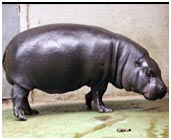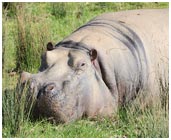Hippopotamus is a huge animal, belonging to the Hippopotamidae family. In this article, we provide you with interesting facts and amazing information on hippo.
Facts About Hippopotamus
Hippopotamus is the third largest animal on land, next to elephant and white rhino. It is one of the only two extant species in the Hippopotamidae family, with the other one being the Pygmy Hippopotamus. They weigh around 3600 kilograms and 15 ft. and 5 ft. tall. Hippopotamuses are found inhabiting rivers, swamps and protected areas, in Sub-Saharan Africa, western Africa, Ethiopia and South Africa and are herbivorous in nature though there have been a sharp decline in their numbers. They spend majority of their time underwater and mostly walk along the bottoms of lakes and rivers, rather than swimming. Having a lifespan of 40 to 50 years, female hippos reach the sexual maturity at the age of 5 to 6 years and have a gestation period of 8 months. To help you know more about hippopotamus, we have provided a number of interesting facts and some amazing information about the animal in the following lines.

Facts Facts
Scientific Name: Hippopotamus amphibius
Kingdom: Animalia
Phylum: Chordata
Subphylum: NA
Class: Mammalia
Order: Artiodactyla
Family: Hippopotamidae
Genus: Hippopotamus
Species: Amphibius
Origin: NA
Diet: Grass, leaves and fruit
Height/Length: 5 feet to 13 feet
Weight: 4,500 kg
Natural Habitat: Rivers, swamps and protected areas (in Africa)
Lifespan: 20-40 years
Type: NA
Status: endangered
Age of Maturity (females): 5 to 6 years
Age of Maturity (males): Average of 7 years
Gestation Period: 224 - 259 days
Number of Offspring: 1-2
Interesting and Amazing Information on Hippopotamus
- Hippopotamus derived its name from Greek, ‘hippos’ which means ‘horse’. Though they were once known as river horses, they have close resemblances to pigs than horses.
- Hippopotamuses are so big that they can easily walk underwater, along the bottoms of lakes and rivers.
- Hippopotamus’s skin itself has a weight of half a ton and is the third largest living mammal in the world next to elephants and white rhinos.
- Hippos are the closest living land mammals to whales and dolphins. Perhaps this is why a hippo can hold its breath for about 5 minutes.
- Hippopotamus is regarded the female deity of pregnancy by ancient Egyptians though Hippos in that country is completely wiped out due to the damage it impose on crops.
- The baby hippopotamus is born under water. While the mother hippo protects them from leopards, crocodiles and other male hippos, some of the baby hippos rest on the back of their water.
- A hippo grazes until dawn may eat up to 68 kilograms of grass a night. They go back to water or lake prior to sunrise in order to avoid the heat.
- Hippos have their nostrils and eyes on their heads which enable them to see and breathe even while they are under the water.
- A hippopotamus does not sweat; rather it excretes an oily, red liquid that protects its skin. This red liquid has given birth to the myth that it sweats blood.
- The ears and nostrils of a hippopotamus close automatically when it goes underwater.
- Hippopotamuses have practically no hair. They have a very smooth skin, which is quite delicate.
- A hippopotamus often yawn as a threatening gesture. While yawning, it displays its long, thick, razor-sharp canine teeth. This, in turn, deters its enemies.
- Hippopotamuses spend most of their day in water. In those areas where there is less human inhabitance, they lie on the shore in morning sun.
- A hippo is the third biggest animal on land. It is slightly smaller, but heavier, than a white rhinoceros.
- The tusk-like incisors and canines of a hippo grow continuously, throughout its life.
- Hippos can easily outrun a human being though they look plump.
- The tusks of a hippopotamus are even more valuable that that of an elephant, since they do not turn yellow with time.
- There are five subspecies of hippos, namely H. a. amphibius, H. a. kiboko, H. a. capensis, H. a. tschadensis and H. a. constrictus.
- Hippopotamuses are territorial in water, where each male hippo controls a small stretch of the river.
- People hunt down hippos for its meat and teeth which is made of ivory.
- The hippo has a huge head which would come to one-third of its total body weight.
- Hippos always live in a herd of 10 to 30 people. A dominant hippo male can mate with all the females in the group.
- Male hippos continue growing throughout their life while the female hippos reach the maximum weight around the age of 25.


See also
More in 'Society'
More from iloveindia.com
- Home Remedies | Ayurveda | Vastu | Yoga | Feng Shui | Tattoos | Fitness | Garden | Nutrition | Parenting | Bikes | Cars | Baby Care | Indian Weddings | Festivals | Party ideas | Horoscope 2015 | Pets | Finance | Figures of Speech | Hotels in India : Delhi | Hyderabad | Chennai | Mumbai | Kolkata | Bangalore | Ahmedabad | Jaipur
- Contact Us Careers Disclaimer Privacy Policy Advertise With Us Lifestyle Sitemap Copyright iloveindia.com. All Rights Reserved.




